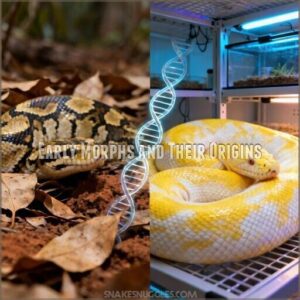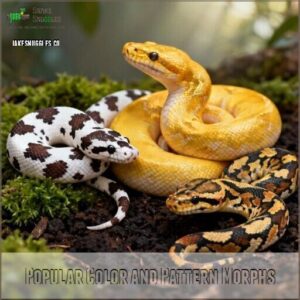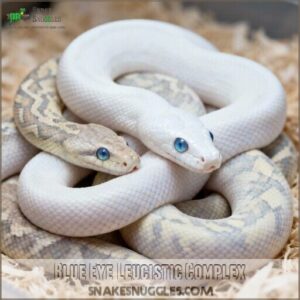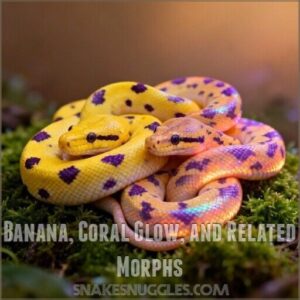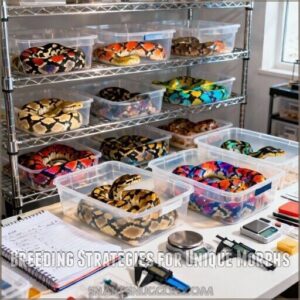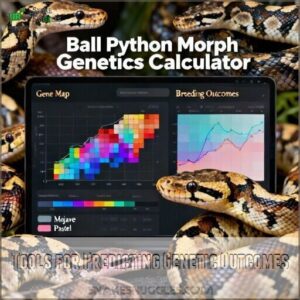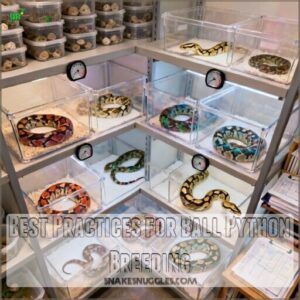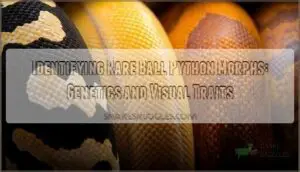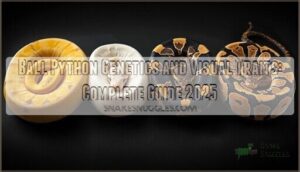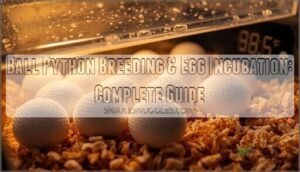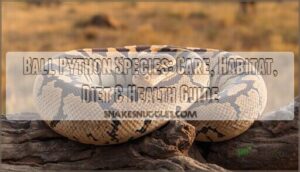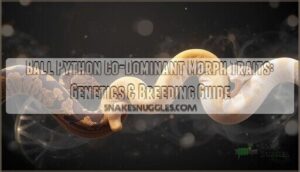This site is supported by our readers. We may earn a commission, at no cost to you, if you purchase through links.
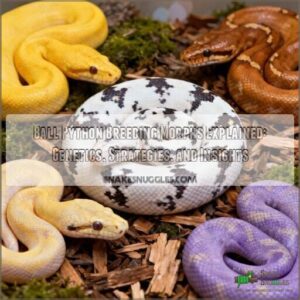 When you cross two ball pythons with different color patterns, you’re not mixing paint—you’re orchestrating a genetic lottery. Dominant alleles, recessive carriers, and co-dominant expressions determine whether you’ll hatch a $50 snake or a $5,000 designer morph.
When you cross two ball pythons with different color patterns, you’re not mixing paint—you’re orchestrating a genetic lottery. Dominant alleles, recessive carriers, and co-dominant expressions determine whether you’ll hatch a $50 snake or a $5,000 designer morph.
Ball python breeding morphs represent one of the most accessible entry points into applied genetics. Hobbyists and professionals manipulate inherited traits to produce snakes displaying everything from solid white bodies to metallic purple patterns.
The mechanics behind these transformations follow Mendelian inheritance principles. Yet, the practical application involves strategic pairing decisions, probability calculations, and an understanding of how multiple genes interact to create increasingly complex phenotypes.
Mastering morph genetics transforms breeding from guesswork into predictable outcomes. This allows you to systematically work toward specific visual goals while addressing the ethical considerations that come with selecting for traits in captive reptiles.
Table Of Contents
Key Takeaways
- Ball python morph breeding follows predictable Mendelian inheritance patterns where dominant alleles express immediately, recessive traits require matching pairs, and co-dominant genes produce intermediate appearances—allowing breeders to systematically calculate probabilities and work toward specific visual outcomes rather than relying on guesswork.
- Multi-gene designer morphs command premium prices ($2,500-$18,000+) by stacking three or more genetic traits, but successful breeding requires tracking bloodlines meticulously to avoid incompatible lines, maintain genetic diversity, and prevent inbreeding that compromises trait consistency across generations.
- Ethical breeding demands prioritizing animal welfare over market trends by selecting against documented genetic health issues like Spider morph head wobble (100% prevalence), Super Cinnamon craniofacial defects (25% of hatchlings), and Caramel Albino spinal kinking (60% of cases)—recognizing that responsible practices shape captive population welfare beyond simple market inventory.
- Breeding success depends equally on genetic knowledge and husbandry precision, requiring optimal temperature gradients (88-92°F warm side, 78-80°F cool side), proper humidity control (50-60% normally, 80-90% during incubation), and understanding that females need 2-3 years and 1,500 grams before reaching breeding maturity while males mature faster at 18 months and 700 grams.
Ball Python Morph Genetics Explained
Before you start pairing snakes or picking out new morphs, it helps to get a grasp on how ball python genetics really work.
Here’s a breakdown of the core terms and ideas you’ll come across. This foundation makes it much easier to sort through your options ahead.
Key Genetic Terminology (dominant, Recessive, Co-dominant, Heterozygous)
Genetics has a language of its own, and getting comfortable with key terms is your first step toward unraveling the secrets behind ball python morphs. Dominant Expression refers to traits you see right away, while Recessive Traits stay hidden unless doubled. Co-dominant Genes produce intermediate appearances, and Heterozygous Carriers possess a recessive gene without showing it, all driving genetic inheritance.
How Morphs Are Inherited
Now that you’ve got a grasp on the basic genetic terms, let’s unravel how these building blocks work together to shape the look of every ball python hatchling. Gene expression follows Mendelian genetics: dominant mutations show right away, while recessive genes need a matching pair.
Polygenic inheritance can add complexity, subtly blending multiple genes to create unique visual traits with each clutch.
Understanding Wild-type Vs. Morphs
Once you know how traits pass from parents to babies, it’s easy to see why wild-type ball pythons look so consistent—and why the wild world of morphs stands out by comparison.
Consider these differences:
- Wild-type traits reflect natural selection
- Morph identification relies on genetic diversity
- Morphs exhibit dramatic color variation
- Conservation impact differs for morphs and wild-types
Role of Genetics in Creating New Morphs
When you breed ball pythons, you’re working with a vivid palette of genetic traits in snakes. Morph genetic tests identify carriers, while allelic series and compound heterozygotes make for surprises in every clutch.
It’s this steady pursuit of genetic diversity that brings designer morphs to life—pushing ball python morph genetics beyond nature’s original blueprint. Some breeders focus on recessive gene combinations to create unique morphs.
Common Ball Python Morphs and Variations
Ball pythons come in an impressive range of colors and patterns, shaped by decades of careful breeding. Certain morphs set the tone for what’s possible in the hobby today.
Let’s walk through some of the most common types you might encounter.
Early Morphs and Their Origins
Think back to the wild origins of ball pythons: early morphs like Albino and Pastel were rare treasures, each discovered in African imports. At first, initial prices soared as these unique genetic mutations changed the landscape of selective breeding.
Hobbyist impact was immediate—morphs transformed ball python genetics, fueling an explosion of new possibilities for color and pattern. Breeders now combine existing morphs, developing captive-bred morphs every year.
Popular Color and Pattern Morphs
From the gold-brightened Pastel—the reigning champion by Morph Popularity—to the high-contrast, dramatic appeal of Piebald and the bold markings of Clown, Ball pythons showcase astounding pattern variations.
Market prices reflect color intensifiers and Designer Combinations, with Pastels generally affordable, Clowns commanding a premium, and Piebald morphs valued for their striking Ball python color variations.
Blue Eye Leucistic Complex
While there’s no mistaking a pure white ball python, the story behind the Blue Eye Leucistic complex is every bit as fascinating as the snakes themselves. These morphs result from Leucistic Combinations within distinct genetic groups, creating signature blue-tinged eyes. Even seasoned breeders tackle Breeding Challenges in Visual Identification, with Genetic Similarities blurring the lines between Complex Variations.
- Mojave, Lesser, and Butter lines contribute to Leucistic offspring
- True identification requires understanding Ball python genetics
- Some gene pairings yield slight pattern traces; others, solid white snakes
- Breeding outcomes can surprise, reinforcing careful Ball python breeding
Banana, Coral Glow, and Related Morphs
Ever wonder why some ball pythons look like they’ve been dusted with sunlight or splashed with lavender freckles? These are Banana and Coral Glow morphs—two sides of the same genetic coin. The controversy? It’s all in the naming. Breeders often debate Banana identification and Coral Glow genetics, as subtle differences spark questions about similar morphs and breeding outcomes.
| Morph | Key Features | Naming Controversy |
|---|---|---|
| Banana | Yellow, purple spots | “Banana” vs. “Coral Glow” |
| Coral Glow | Almost identical | Debate on distinct lines |
| Similar Morphs | Subtle variations | Genetics mostly shared |
| Breeding | Pastel x Banana yields vibrant Clutch | Names get mixed in records |
Breeding Strategies for Unique Morphs
There’s more than one way to pair genes and create standout ball python morphs. Each approach brings its own mix of possibilities and surprises.
Here’s a look at some tried-and-true strategies breeders use to develop unique combinations.
Recessive and Double Recessive Breeding
If you want to discover the rarest patterns in a ball python clutch, recessive genetics are where the real magic happens. Recessive inheritance requires both parents to carry the gene—sometimes only as “hets”—making visual identification tricky.
Double recessive combos ramp up the challenge. A genetic calculator is essential for estimating breeding odds, tracking genetic traits, and breeding new combinations reliably.
Co-dominant and Super Form Combinations
With codominant traits like pastel or mojave, breeding two snakes with the same incomplete dominance gene can yield so-called “super” forms—striking and unmistakable examples of super form genetics.
These combinations simplify visual identification but complicate breeding matters, since each gene combination creates opportunities for new morph creation, making codominant gene inheritance key for breeding new combinations and unique snake morph combinations.
Mixing Dominant, Co-dominant, and Recessive Genes
Once you’re familiar with how super forms work, it’s only natural to start blending dominant, co-dominant, and recessive genes to see what else you can bring to life in the rack. Understanding gene interaction and complex inheritance lets you predict visual outcomes—but breeding challenges multiply fast.
Codominant and recessive gene inheritance weave intricate snake morph combinations, requiring careful strategy to anticipate ratios and genetic traits in snakes.
Creating Multi-gene Designer Morphs
Morph stacking—layering three, four, or even more gene combinations—pushes ball python breeding into designer territory, where phenotype enhancement and market valuation skyrocket. By 2025, multi-gene morphs like "Dreamsicle" or "Confetti" command prices from $2,500 to over $18,000, depending on genetic compatibility and rarity.
You’ll face clutch variability and genetic outcomes that deviate from calculators, but genetic verification through DNA testing helps confirm what you’ve hatched and whether your breeding project is on track.
Tools for Predicting Genetic Outcomes
Predicting what you’ll get from a breeding pair isn’t guesswork—it’s math you can actually use. Online genetics calculators and tracking tools take the mystery out of probability, showing you exactly which combinations produce which morphs.
Here’s how to use these resources to plan your breeding projects with confidence.
Using The WOB Genetics Wizard
How should you approach the WOB Genetics Wizard to get the most out of your breeding simulations? This tool streamlines genetic calculation by letting you input specific morphs and instantly visualize potential offspring. The Wizard interface simplifies morph identification and gene selection, making complex genetic outcomes accessible even for newer breeders.
Here’s how to use it effectively:
- Type the morph name in the male or female gene field and select from the provided list
- Build complex genetics by adding multiple genes to each parent snake
- Review the calculated outcomes showing percentage probabilities for each potential morph
- Benefit from regular updates that improve accuracy and expand the morph database
The tool treats snakes without added genes as normal wild-type ball pythons, establishing your baseline for predictions.
Calculating Breeding Results and Odds
After you’ve mapped out potential outcomes in the Wizard, understanding the actual percentages behind each result sharpens your breeding decisions and helps you set realistic expectations for clutch composition. Each breeding scenario follows predictable genetic probability patterns based on how alleles combine. Punnett squares underpin these calculations, showing heredity ratios for specific phenotype outcomes.
However, clutch size and statistical variation mean individual breeding outcomes won’t always mirror the genetic calculator’s predictions—you’ll need multiple clutches to see patterns emerge across your breeding program.
Identifying Morphs and Gene Selection
Pinpointing exactly which genes you’re working with—whether you’re evaluating a breeding prospect or trying to decode a visual morph you already own—requires a systematic approach that blends visual identification, genetic knowledge, and sometimes a bit of detective work tracing lineage.
Start by examining the phenotype carefully: pattern disruption, color saturation, and specific genetic markers like head stamps or belly patterns help narrow down candidate genes.
Common beginner mistakes include confusing similar morphs—Cinnamons versus Black Pastels, for instance—or overlooking hidden alleles that affect morph compatibility in future pairings.
Importance of Tracking Bloodlines
Keeping careful records of your snakes’ ancestry isn’t just about organization—it’s the foundation for predicting outcomes, avoiding genetic pitfalls, and building a reputation as a breeder who truly understands what’s behind each scale.
Documented bloodlines reveal lineage health and help you maintain genetic diversity, preventing inbreeding that compromises trait consistency.
Different ball python bloodlines—like various pastel or albino lines—may not be compatible, so tracking genetic variation across your breeding programs is essential for future-proofing your collection and preserving the genetic traits that define quality morphs.
Best Practices for Ball Python Breeding
Successful ball python breeding hinges on more than just understanding genetics—you need to create the right conditions, treat your animals responsibly, and recognize potential problems before they escalate.
Whether you’re setting up breeding enclosures, raising delicate hatchlings, or addressing ethical concerns, each decision shapes both your results and the health of your snakes.
Let’s break down the essential practices that separate thoughtful breeders from those who cut corners.
Ideal Breeding Environments and Care
You can’t expect to produce championship morphs if your breeding pairs are housed in suboptimal conditions—creating the right environment is just as important as selecting the right genes.
Adult ball pythons thrive when you maintain temperature gradients between 78–80°F on the cool end and 88–92°F on the warm side, paired with humidity control around 50–60%.
Enclosure size matters—provide adequate space with appropriate substrate choices like cypress mulch or paper towels.
Always implement quarantine protocols for new animals before introducing them to your breeding programs.
Managing and Raising Hatchlings
Hatchlings emerge from their eggs already equipped with the same genetic blueprint as their parents—but transforming that potential into healthy, thriving juveniles requires precision in temperature management, feeding protocols, and early husbandry decisions.
You’ll need to set up individual hatchling housing in small plastic containers with proper heat gradients. First feeding usually occurs after the initial shed, usually within 7–10 days post-hatching. Monitor shedding issues closely, as incomplete sheds signal humidity problems.
Growth rates vary by genetics and feeding frequency, while common ailments include respiratory infections and feeding refusals that require immediate attention.
Ethical Breeding Considerations
Breeding ball pythons demands more than genetic knowledge—it requires a commitment to responsible breeding that prioritizes morph health over market trends. Overproduction issues plague the industry when breeders chase novelty without considering genetic defects or the conservation impact of captive breeding programs.
Responsible breeding prioritizes morph health over market trends, preventing overproduction and genetic defects that harm captive populations
Before pairing snakes with dominant traits or incomplete dominance, evaluate whether your reproduction goals serve the species’ welfare or simply flood an already saturated market. Ethical snake breeding means selecting against known health problems and refusing to produce morphs that compromise quality of life.
Recognizing and Addressing Genetic Health Issues (e.g., Head Wobble)
Headwobble in Spider morphs stems from malformed inner ear structures—100% of examined individuals display symptoms ranging from mild tremors to severe corkscrewing.
Super Cinnamon and Super Black Pastel combinations carry craniofacial defects in up to 25% of hatchlings, while Caramel Albino lines show spinal kinking in roughly 60% of cases. Desert females face subfertility risks, and certain Blue-Eyed Leucistic pairings with Piebald produce eye malformations in 15% of offspring.
Incomplete dominance doesn’t excuse breeding morphs with documented health issues—responsible snake breeding means selecting against wobble severity and other genetic problems.
Frequently Asked Questions (FAQs)
What are the startup costs for breeding ball pythons?
Starting a breeding operation demands significant financial commitment across multiple categories. Initial Enclosure Costs and Hatchling Rack Systems usually range from $500-$2,000, depending on scale. Incubation Equipment Costs add another $200-$
Food Source Setup requires freezer space and rodent supplies. Genetic Testing Expenses vary by morph complexity.
How long until ball pythons reach breeding maturity?
Male ball pythons usually reach breeding maturity around 18 months or 700 grams, while female ball pythons need closer to two to three years and 1,500 grams before they’re ready to produce their first clutch.
Size matters more than age factors alone for successful breeding outcomes.
What temperature and humidity are needed for breeding?
As the saying goes, "proper preparation prevents poor performance." Temperature gradients between 88-92°F on the warm side and 78-80°F on the cool side create ideal breeding conditions for ball pythons.
Humidity levels should remain around 50-60% normally, increasing to 80-90% during egg incubation to guarantee healthy clutch development.
How do you incubate ball python eggs properly?
Proper incubation requires maintaining temperature between 88-90°F and humidity around 90-100%. Use vermiculite or perlite as your incubation medium.
Check the clutch regularly through egg candling to monitor embryo development without disturbing the female or male’s basic gene expression in resulting morphs.
Which morphs have the highest market value currently?
Market trends show that rare morph combinations like high-white Piebald, BEL (Blue Eye Leucistic) complexes, and multi-gene designer morphs command premium prices.
Rarity factors and investment potential drive demand, with future projections favoring unique albino combinations and proven breeding animals.
Conclusion
Fortune favors the prepared mind"—and in ball python breeding morphs, preparation means mastering inheritance patterns before pairing your snakes. You’ve learned to calculate probabilities, recognize gene interactions, and anticipate phenotypic outcomes.
Apply this genetic framework systematically, but never lose sight of the living animals behind the percentages. Track bloodlines carefully, breed ethically, and acknowledge that every hatchling represents both scientific principle and biological responsibility.
Your breeding decisions shape not just market inventory, but the welfare of captive populations.

